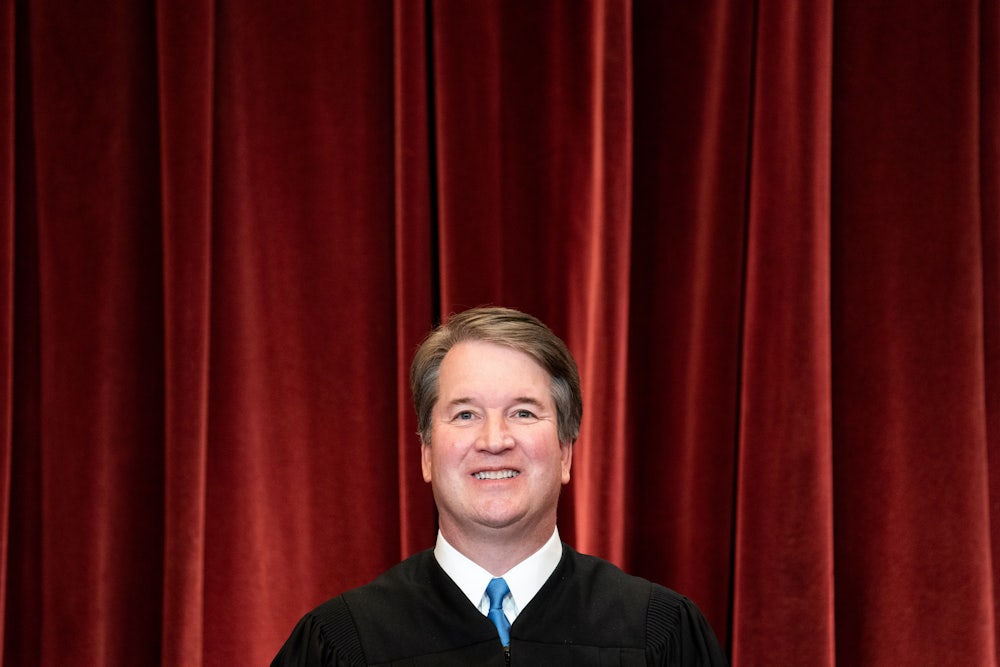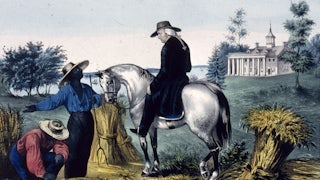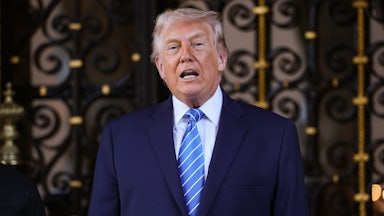The highest-profile cases at the Supreme Court mostly follow a familiar pattern these days. There is a majority opinion that’s almost always written by one of the court’s six conservatives. There is also a dissenting opinion that’s usually written by one of the court’s three liberals. And then, when the stakes are highest, there is almost always a concurring opinion by Justice Brett Kavanaugh—a Columbo-like afterthought tacked on to virtually every major case that the court hears.
In the last few months, Kavanaugh wrote separately (and almost always alone) to explain his majority vote in the court’s major decisions on the Indian Child Welfare Act, the Voting Rights Act, and affirmative action in college admissions. His writings in these cases and in other recent landmark decisions highlight the shifting bounds of the court’s strengthened conservative majority—and how far it may be willing to go to reshape the American legal system in its own image.
In Haaland v. Brackeen, the ICWA case, the court effectively maintained the status quo by dismissing parts of a legal challenge to the law on procedural grounds and by rejecting their other arguments out of hand. It was not exactly a full-throated endorsement of ICWA: Justice Amy Coney Barrett, writing for a 7–2 majority, pointedly declined to affirm the law’s constitutionality in some places. Instead, she simply ruled that the challengers just hadn’t made sufficiently convincing arguments.
Kavanaugh, for his part, joined Barrett’s majority opinion in full. But he also wrote separately to signal how he might vote in a future ICWA challenge. “In my view, the equal protection issue is serious,” he wrote. “Under the Act, a child in foster care or adoption proceedings may in some cases be denied a particular placement because of the child’s race—even if the placement is otherwise determined to be in the child’s best interests.” (Tribal membership and race are not the same thing under the court’s precedents, as I’ve noted elsewhere before and as Justice Neil Gorsuch has probably explained to his colleagues countless times.)
While he agreed with the court’s conclusion that the parties in the Brackeen case didn’t have standing to raise that argument, Kavanaugh outlined how the court might be able to rule on it in the future. “Courts, including ultimately this Court, will be able to address the equal protection issue when it is properly raised by a plaintiff with standing—for example, by a prospective foster or adoptive parent or child in a case arising out of a state-court foster care or adoption proceeding,” he explained. He might as well have sent up a signal flare to future litigants to bring him the case.
A few weeks earlier, in Allen v. Milligan, Kavanaugh wrote a four-page concurring opinion that largely reiterated points from Chief Justice John Roberts’ majority opinion. If anything, it reads as a more direct critique of the legal arguments Alabama used to explain why the Voting Rights Act does not require it to draw an additional majority-Black congressional district. But he concluded it by noting that he might be open to a legal challenge against the VRA’s protections that Alabama did not raise in this litigation, namely that Congress’s ability to require “race-based redistricting,” as he put it, “cannot extend indefinitely into the future.”
And in this term’s affirmative action cases, he wrote separately to suggest that he supported a middle course on race-conscious college admissions. Whereas Justice Clarence Thomas and some of the other justices would rule that such policies were always unconstitutional, Kavanaugh wrote that he agreed with the court’s precedents that found them constitutional for a limited time period after segregation and Jim Crow. He also extended an olive branch of sorts to the court’s three liberal dissenters, writing that he “respect[ed] their views” on the constitutionality of such programs and only parted ways on how long they could last.
Supreme Court justices typically have the opportunity to pen three kinds of opinions. Majority opinions are the best ones to write, of course: They alone carry the force of law. Dissents are much less enjoyable. Their authors use them to express disagreement with the majority for its decision, meaning they are always written in defeat. A dissent’s intended audience can be the other justices, the other branches of government, law school students, legal scholars and academics, or the American public itself. They may even serve as a roadmap for future justices to overturn the ruling from which they dissent.
Every justice also occasionally writes the third type of opinion: concurrences, which fill a less clear-cut role in the court’s internal discourse. In most instances, they are used to explain why a justice only agrees with part of a decision and why they part ways on other aspects. A justice might write one to emphasize something about the decision that they see as particularly important, to defend a majority opinion from the barbs of a dissent, or to explain the weakness of a particular precedent that they nonetheless rely upon. But there is no paradigmatic concurring opinion; they are each unique to the circumstances in which they were written. And like dissenting opinions, they do not carry the force of law.
The Supreme Court did not always even issue concurring opinions—or, depending on how you look at it, its members used to only write concurring opinions. In the court’s earliest days, the justices delivered their opinions seriatim, a Latin legal term meaning that each justice writes an individual opinion. Lawyers then read those opinions together to determine the court’s actual holding. Early American judges inherited this practice from the British system, and it was difficult and as confusing as it sounds.
John Marshall, the nation’s fourth chief justice and the first one who actually mattered, began drafting majority rulings to explain the court’s reasoning after he joined it in 1801. Dissenting and concurring opinions by other justices soon followed. Some dissenting opinions, like John Marshall Harlan’s famous rebuke of segregation in Plessy v. Ferguson or the three justices’ separate dissents in Korematsu v. United States, can ultimately eclipse those of the majority. Famous concurring opinions are few and far between.
Kavanaugh is also not the court’s most prolific drafter of concurring opinions. That title currently goes to Justice Clarence Thomas, who typically uses them to expound upon his own legal and constitutional theories, according to data compiled by Adam Feldman, an expert on Supreme Court statistics. Thomas often uses his dissents to point out how the court should do things differently; he typically uses concurring opinions to explain how he would have gone further and faster than his colleagues in changing precedent. That ideological vision sets him apart from Kavanaugh, who tends to be more surgical and pragmatic in how he drafts concurring opinions.
In some instances, Kavanaugh appears to use concurring opinions to limit the scope of majority rulings that he joins—or at least to signal that he won’t go any further than the ruling on a particular issue. When the Supreme Court overturned Roe v. Wade last summer, Kavanaugh wrote separately to explain that he considered the justices’ preeminent role in abortion rights debates to be over. “Because the Constitution is neutral on the issue of abortion, this Court also must be scrupulously neutral,” he wrote. “The nine unelected Members of this Court do not possess the constitutional authority to override the democratic process and to decree either a pro-life or a pro-choice abortion policy for all 330 million people in the United States.”
At the same time, Kavanaugh also signaled that he would not support some restrictions on abortion if they implicated other constitutional rights. “For example, may a State bar a resident of that State from traveling to another State to obtain an abortion?” he wrote. “In my view, the answer is no based on the constitutional right to interstate travel. May a State retroactively impose liability or punishment for an abortion that occurred before today’s decision takes effect? In my view, the answer is no based on the Due Process Clause or the Ex Post Facto Clause.”
Justices occasionally tip their hand on how they would decide future cases in concurring and dissenting opinions, but they are rarely so blunt about it. Kavanaugh took a similar tack in New York State Rifle and Pistol Association v. Bruen last term. In that case, the court struck down New York’s highly discretionary scheme for issuing concealed-carry licenses and imposed a new history-and-tradition test for Second Amendment claims. Kavanaugh joined the majority opinion but wrote separately to emphasize that some guardrails remained.
The Bruen ruling, he noted, did not address “shall-issue” permitting regimes that exist in most states, only the “may-issue” regimes in New York and a handful of others. “Going forward, therefore, the 43 States that employ objective shall-issue licensing regimes for carrying handguns for self-defense may continue to do so,” Kavanaugh explained, effectively tipping his hand on potential legal challenges to those schemes. He also reiterated his support for language in gun rights rulings that suggested a wide range of existing gun restrictions would still be constitutional. Roberts notably joined Kavanaugh’s opinion this time, all but confirming that there are not five votes on the court for reversing those earlier assurances.
I cannot help but wonder what Kavanaugh’s colleagues make of his strategic concurrences, particularly those on the right. They almost always go unmentioned in the court’s other writings, like most other concurring opinions. The sole recent exception came in the VRA case, where Thomas appeared to chastise his colleague for trying to have it both ways. While he took note of Kavanaugh’s claim that he might be willing to hear a different VRA challenge in the future, Thomas wrote in his own dissent that Kavanaugh nonetheless “vote[d] to sustain a system of institutionalized racial discrimination in [re]districting.” The court’s senior-most justice is apparently uninterested in Kavanaugh’s caution or half measures.
In that sense, Kavanaugh’s concurring opinions provide a unique window into the Supreme Court’s intra-conservative debates. It is clear from some decisions this term, most notably in the ICWA and VRA cases, that Roberts, Kavanaugh, and Barrett will occasionally break ranks with the other three conservative justices. (Gorsuch also joined the ICWA majority, reflecting his unusually vivid views on tribal sovereignty.) This does not mean they are moderates, only that they reflect a more median position on the court’s ideological spectrum. After all, a genuinely moderate court would not be considering frontal challenges to the Voting Rights Act or the Indian Child Welfare Act in the first place.










